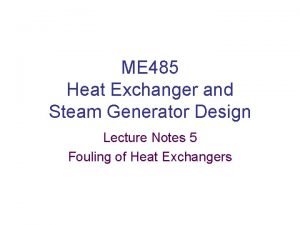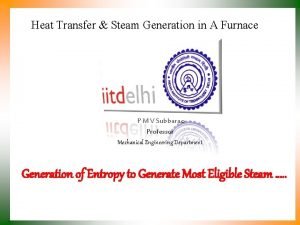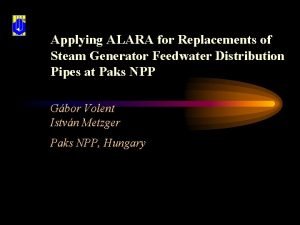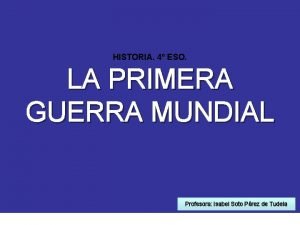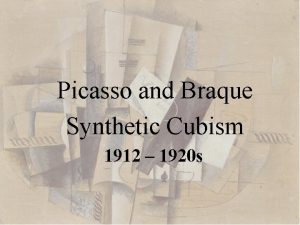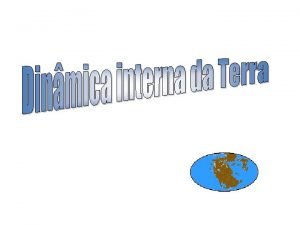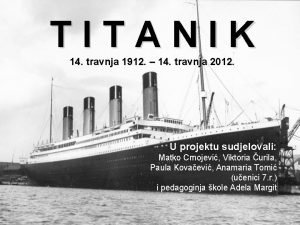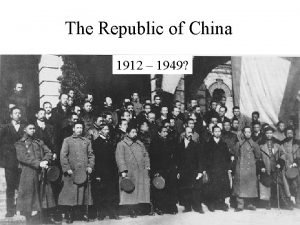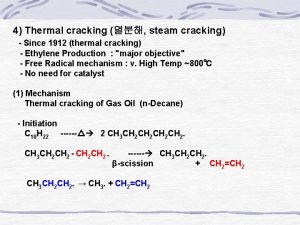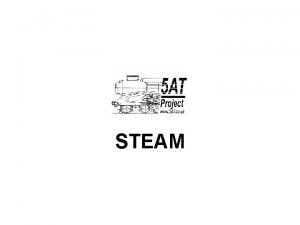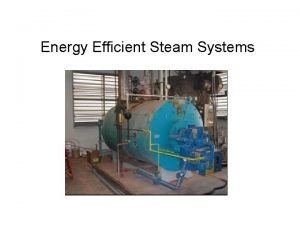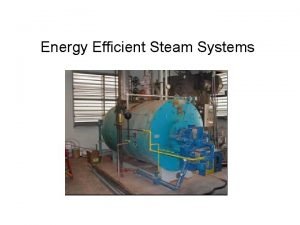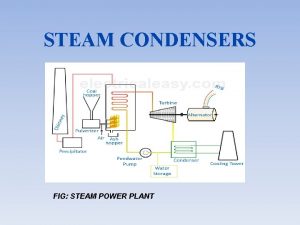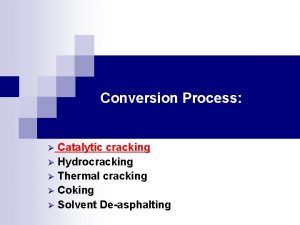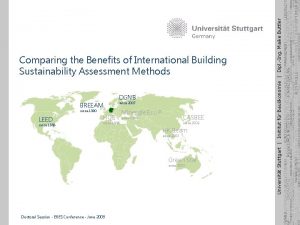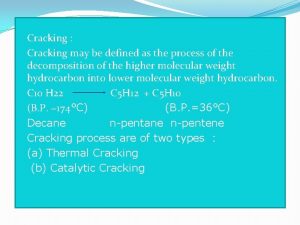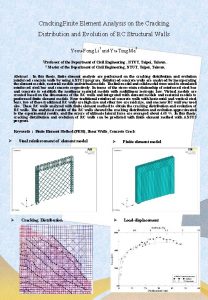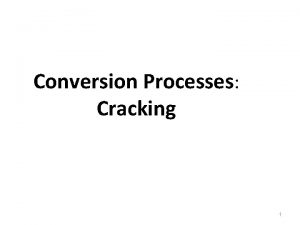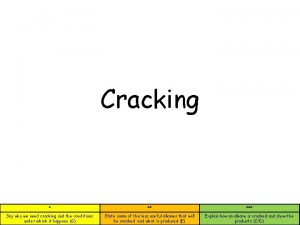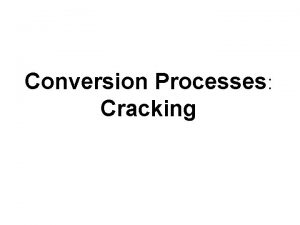4 Thermal cracking steam cracking Since 1912 thermal





















- Slides: 21

4) Thermal cracking (열분해, steam cracking) - Since 1912 (thermal cracking) - Ethylene Production : "major objective" - Free Radical mechanism : v. High Temp ~800℃ - No need for catalyst (1) Mechanism Thermal cracking of Gas Oil (n-Decane) - Initiation C 10 H 22 ------△ 2 CH 3 CH 2 CH 2․ CH 3 CH 2 - CH 2 ․ ------ CH 3 CH 2․ β-scission + CH 2=CH 2 CH 3 CH 2․ → CH 3․+ CH 2=CH 2

- Propagation CH 3․ + RH → R․ + CH 4 CH 3 CH 2 CH 2 CH 2 - CH 2 CH․ - CH 2 ------ β-scission CH 3 CH 2 CH 2 CH 2․ + CH 2=CHCH 2 CH 3 CH 3 CH 2․ → CH 2=CH 2 + H․ - Termination RCH 2․ + ․CH 2 R → RCH 2 -CH 2 R

(2) Steam Addition Required - Termination, Chain transfer reaction : Bimolecular rxn - Low partial Press: Inhibits Bimolecular reaction (3) High Temp Required - High Temp favors homolysis and β-scission - High Temp : no effect on termination (∵ Ea ~ O) RCH 2․ + ․CH 2 R → RCH 2 -CH 2 R (4) Choice of feedstock - Ethylene production highly depends on the feeds (Ethane > Naphtha > GO : MW of feed ) - Little by product (propylene, 사생아? ) with Ethane - Propylene surplus Propylene shortage in the early 1990’s EU/Jp is ok with naphtha, USA is ok with Catalytic Cracking (gasolin)

5) Catalytic Reforming (Reforming) (1) 목적 : - Improve O. N. of gasoline (1950, UOP) 40 ℃ < b. p. < 90 ℃ : O. N. of straight run gasolin, 40 → 95 - Production of aromatic compounds from light Naphtha (C 6 -C 8 ) ~ 50% production (w/w) (cf) Production of H 2 : ~ 15% w/w) (2) Reactions - Dehydrogenetion of cyclo-6 to aromatic compounds Methylcyclohexane → Toluene + 3 H 2 - Dehydroisomerization of cyclo-5 Methylcyclopentane → Benzene + 3 H 2 - Dehydrocyclization of alkanes to aromatic compounds

(minor reactions) - Hydrocraking of Alkane (Hydrogenolysis) n-C 7 H 16 + H 2 → C 3 H 8 + C 4 H 10 - Isomerization of Alkane n-C 5 → CH 3 CH(CH 3)CH 2 CH 3 cf. High O. N. ← Aromatic compounds (3) Process ※ Catalyst : Dual Function Catalyst (이원 촉매) Catalyst effectiveness ∝ distance between two sites Acidic site: (Si. O 2/Al 2 O 3) : RDS Hydrogenation - Dehydrogenation site : (Pt) A → B → C (good system when difficult to achieve by successive beds of two catalyst)

- Operation Temp. : 450 -550 ℃ … gas-phase reaction H 2 존재 하에 반응 (10 -50 atm), Pt/Al 2 O 3 - Si. O 2 평형 반응은 Low partial press H 2 을 요구하나 “coke"- formation 방지 때문 • Platforming Process : Platinume + Reforming (UOP) H 2 : HC = 5 -10 : 1 (Feed Ratio) Series of diabetic Reactors (#3 -5) Reheater between Reactors (∵) endotherm rxn • Rheniforming process : Pt-Re/Al 2 O 3 - Si. O 2 • Multi-metal Cluster Catalyst

(4) Mechanism - Dehydro-isomerization of Cyclopentane Dehydrogenation + Carbocation reaction eg) Methylcyclopentane Cyclohexene - Isomerization of Alkanes: paraffin to iso-paraffin CH 3 CH 2 CH 2 CH 3 == CH 3 CH 2 CH=CHCH 3 + H 2 (D) CH 3 CH 2 CH=CHCH 3 + H+ == CH 3 CH 2 CH + CH 2 (A) CH 3 CH 2 CH + CH 2 == iso-pentane - Paraffin to Aromatics

(5) Byproduct H 2 : large scale production Raw material for Hydrocracking Raw material for NH 3 production (6) Separation of Products : Complicate and Difficult (eg) Separation of Xylene o-Xylene (bp 144. 4, mp - 25 ℃) m-Xylene (bp 139. 1, mp - 47. 9 ℃) p-Xylene (bp 138. 3, mp 13. 2 ℃ ) - Need 200 plates distil. column - Isolated by crystallization at - 60 ℃

(eg) Recovery of Aromatics from Reforming Products Cooling → (Gas + Liquid) - Gas : HC (C 1 -C 4), H 2 - Liquid : >C 5 Condensates → Aromatics recovered by extraction with Sulfolane Glycol/H 2 O N-methylpyrolidone/EG - To meet the market demand, • Need isomerization of Xylenes • Need dehydroalkyation of Toluene to Benzene 68, Table 2. 9

6) Alkylation (catalytic Alkylation) “olefin (C 3 or C 4) + paraffinic HC" eg) i-butene + i-butane + str. H+ → isooctane (1) General characteristics - produce high O. N. gasoline contents (>90) - best possible motor fuel 생산 - use isobutane only eg) isobutane, propene, butene, … (by products of catalytic cracking or oil distillation process gas) - very important in U. S refinery process (2) Reaction of isobutane + propylene → branched HC mixtures - 96 -98% H 2 SO 4 : 0 -10℃ (냉동장치 要… E cost) - HF : 50℃ (high cost, safety!)

(3) Mechanism - Initiation : by protonation CH 3 CH=CH 2 + HF → CH 3 CH+CH 3 + F- - Hydride abstraction : (CH 3)3 C-H + CH 3 CH +CH 2 → t-butyl cation + CH 3 CH 2 CH 3 (only i-butane 을 쓰는 이유 : stable cation) - Rearrangement : ~ 1, 2 H shift or ~1, 2 alkyl shift for further branching

7) Polymerization - Converts C 3, C 4 olefine → olefinic gasoline - WWⅡ 중 중요 process : 비행기 연료 등 생산 C 3, C 4 olefine (by-prod of cracking) → 중합 gasoline - Propylene trimer, tetramer → alkylbenzene ―→ detergents (경성세제) ↑ sulfonation 8) Isomerization (Catalytic Isomerization) (1) 목적 - n-butane + Al. Cl 3 → isobutane (as a feedstock for alkylation) if , >C 5, tar formation 등 side rxn - straight run gasoline → branched gasoline (high O. N)

(2) Reaction C 4 H 10 + HCl + Al. Cl 3 → C 4 H 9+ + Al. Cl 3 - + H 2 R+ + CH 3 CH 2 CH 3 → RH + CH 3 -CH+-CH 2 -CH 3 → 1, 2 H shift → 1, 2 Alkyl shift → t-butyl cation → i-butane - Chain rxn 이므로 약간의 C + 만 필요함.

Unleaded gasoline & Clean Air Act - Catalytic cracking, TEL/EDB → High ON gasoline - lead bromide emission : toxic Unleaded gasoline w/ high ON needs - Oligomerization: reactivated process - Alkylation - Catalytic cracking catalyst 개발 - Catalytic reforming ? By Clean Air Act (1991) demanded lower aromatics & oxygenate source - Benzen contents (3 % 1%) - Aromatics (36 % 25 %) by EPA - New demand for MTBE (Me. OH and isobuten) (same amount as Ethylene)

Olefin Metathesis reaction (복분해 반응) 1) Metathesis 2 CH 2=CHCH 3 → W (Mo, or Re) → CH 2=CH 2 + CH 3 -CH=CH-CH 3 - Phillips Tri-olefin Process Hydrocarbon Process, 46, 232, Nov, 1967 - Usually get equilibrium mixture of three olefin - Driving force for the product → CH 2=CH 2 ↑ 2) Economy - Cheap propylene → Expensive products - Butene (Butadiene feed stock): difficult to separate from C 4 cracking product 3) Mechanism

4) Other applications ① CH 2=CH 2 + Ph. CH=CH-Ph → 2 Ph CH 2=CH 2 - Stilbene to Styrene ( Monsanto) - 2 Ph-CH 3 → Ph. CH=CHPh (via Oxidative Coupling) ② 1, 7 -Octadiene → Cyclohexne + CH 2=CH 2 ※ driving force : "formation of cyclohexene” - Poor substrate ③ 2 Cyclopentene → 1, 5 -Cyclodecadiene n Cyclopentene → Pentenomer (ROM polymerization product) ※ Grubbs Catalyst: Ruthenium Complex, Nobel 상 (2005)

2005 노벨 화학상 Chauvin Yves Institute Francais du Petrole 에이즈 치료제와 생물농약, 콘택트렌즈 등에 쓰이는 유기화합물을 합성하는 ‘복분해’(metathesis) 방법을 개발 Richard R. Schrock Department of Chemistry Massachusetts Institute of Technology Robert H. Grubbs Division of Chemistry and Chemical Engineering California Institute of Technology

Olefin Metathesis Ø Yves Chauvin (chauvin mechanism) Ø Richard R. Schrock Molybdenum and Tungsten catalyst Ø Robert H. Grubbs Ruthenium catalyst

④ pheromone synthesis CH 2=CHC 8 H 17(1 -decene) + CH 2=CHC 13 H 27(1 -pentadecene) → CH 2=CH 2 + C 8 H 17 CH=CHC 13 H 27 - cis-comp`d … housefly pheromone - simple rxn, but separation difficult * other applications : See 77

5) Industrial Application (SHOP) - Olefin Metathesis reaction : Shell Higher Olefin Process (SHOP) See 102 ① Oligomerization of ethylene n C 2 H 4 → (C 2 H 4)n-1 CH=CH 2 : α-olefins C 4 -C 8 41 % C 10 -C 18 40. 5% → separation of C 10 -C 18 olefins by distill C 20~ 18. 5% ② Isomerization of others (C 4 -C 8 + C 20~) to Internal Olefins C 4 -C 8 (low boiling) C 10 -C 18 (high boiling)

③ Metathesis CH 3 -CH=CH-CH 3 + C 10 H 21 CH=CH-C 10 H 21 → 2 CH 3 CH=CHC 10 H 21 C 4 C 22 C 13 ④ Hydroformylation CH 3 CH=CHC 10 H 21 → CH 2=CHCH 2 C 10 H 21 → CO/H 2 → HCOCH 2 CH 2 C 10 H 21 → HO(CH 2)14 H (OXO alcohols) ※ Linear alcohol : Used for biodegradable detergent
 Steam generator heat exchanger
Steam generator heat exchanger Steam steam generator slag
Steam steam generator slag Steam steam generator erosion
Steam steam generator erosion Present perfect tense of walk
Present perfect tense of walk Caricatura britanica de 1912
Caricatura britanica de 1912 Revolucion china 1912
Revolucion china 1912 Picasso man with violin
Picasso man with violin Miners strike 1912
Miners strike 1912 1912 alfred wegener
1912 alfred wegener Harriet tubman
Harriet tubman Podela makedonije 1912
Podela makedonije 1912 Rubkev
Rubkev 1956-1912
1956-1912 Lunacy act 1912
Lunacy act 1912 14.4.1912
14.4.1912 1912-1949
1912-1949 1912
1912 Bitka na bregalnici crnogorci
Bitka na bregalnici crnogorci Picasso 1912
Picasso 1912 Section 3 using thermal energy
Section 3 using thermal energy Thermal transfer vs direct thermal printing
Thermal transfer vs direct thermal printing Why do we need cracking
Why do we need cracking
